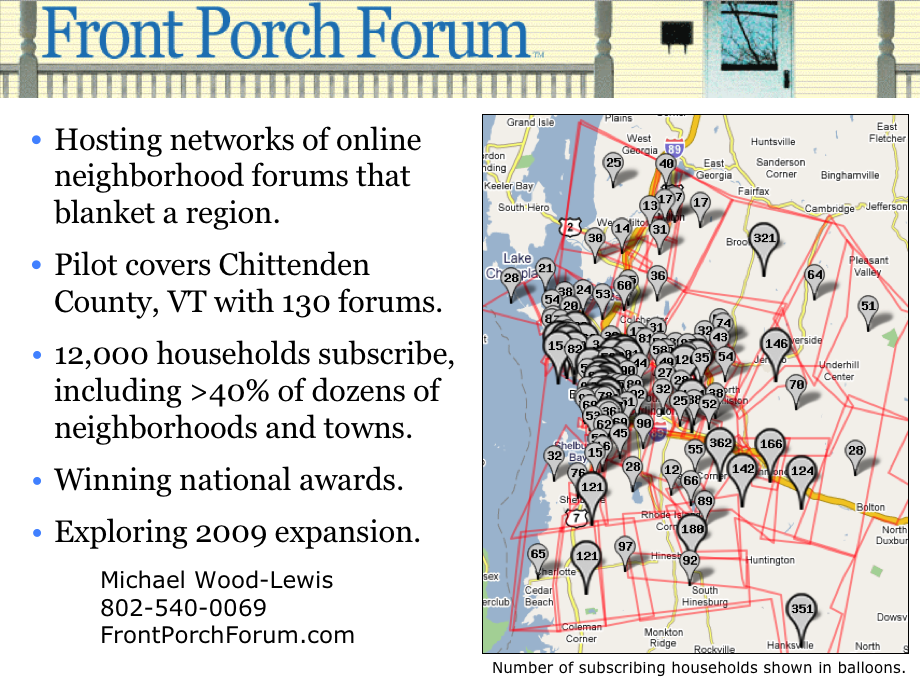Category Archives: Vermont
Eugene Jarecki and Civic Engagement
Mike Ives profiles Vermont filmmaker and author Eugene Jarecki in Seven Days this week. Jarecki’s 2006 documentary, Why We Fight, won the Grand Jury Prize at the Sundance Film Festival.
And he has a new book out…
… he told Jon Stewart recently, he hopes The American Way of War will inspire a sense of common civic engagement that withered during the Bush years. “I’m on a real mission,” he explained to the Comedy Central host. “The worse thing that’s happened is, we’ve become disengaged… ”
And…
Jarecki is trying to make a difference in his community. Neighbors say the Big Picture Theater & Caf© in Waitsfield, which Jarecki co-founded in 2006, is an important civic space for residents of the Mad River Valley.
Good stuff. Many of Jarecki’s Mad River Valley neighbors have asked us to bring Front Porch Forum there… we hope to in 2009… working on pulling pieces together now. In Burlington, where we’ve been operating for two years, a survey found 93% of respondents claiming that FPF led to increased civic engagement for them… real, face-to-face, in the community kind of stuff.
Zip Codes and Polygons
Defining physical boundaries of neighborhoods is a cornerstone of Front Porch Forum. So we’re interested in local boundaries generally. Vermont-based Maponics shares a good primer today about ZIP Codes and carrier routes (and they have neighborhood polygons too)…
The ZIP Code and carrier route coding system was specifically developed by the United States Postal Service (USPS) in order to make mail delivery more efficient. This means that what the average person refers to as a “ZIP Code”, is actually a collection of addresses that have the same 5-digit code assigned to them. The USPS then further splits up each of these ZIP Codes into smaller blocks of addresses: carrier routes. A carrier route literally corresponds to the group of addresses that an individual mail service employee is responsible for delivering to each day.
There are roughly 43,000 ZIP Codes in the US. These are divided into approximately 600,000 unique carrier routes with, on average, 15 carrier routes per ZIP Code. Fifty percent of these are PO Box-based carrier routes which do not have actual delivery areas.
ZIP Codes and carrier routes do not tie in to any other US geography. Because of this, they frequently cross city, census tract, county and even state boundaries. The USPS does not provide maps or map data for ZIP Codes and carrier routes. Businesses looking for postal map data to inform their sales territory tracking, direct marketing and other initiatives have to turn to private map data compilers for this information.
Read the full post…
About Blog
Ghost of Midnight is an online journal about fostering community within neighborhoods, with a special focus on Front Porch Forum (FPF). My wife, Valerie, and I founded FPF in 2006... read more
Post Categories
- Uncategorized
- PDF2009
- Calendar
- Northeast Kingdom
- podcast
- Peer Rental
- Localization
- Big Tech
- Events
- PDF2007
- Web Traffic
- Google AdSense
- Pay It Forward
- Elections
- berkmansunlight
- Maps
- Video
- Upstate New York
- Coupons
- Wildlife
- Mobile
- Viral Marketing
- Raffle
- Crisis Response
- Donations
- Lost & Found
- Real Estate
- College Students
- Gratitude
- Social Responsibility
- Orton Family Foundation
- Start ups
- Make It Your Own Awards
- Best of FPF
- Online Civility
- Clay Shirky
- Newspapers
- Humor
- How To Use FPF
- Online Classified Ads
- Peer Reviews
- Politics
- Community Management
- Economic Development
- Local Reviews
- Case Foundation
- Borrow and Lend
- Neighborhood Watch
- Good Government
- Small Business Advertising
- Citizen Journalism
- e-Vermont
- Democracy
- Local Search
- Knight Foundation
- Burlington
- MacArthur Fellows
- Civic Engagement
- Social Media
- social capital
- Social Networking
- Vermont
- Neighborhood
- Community Building
- Local Online
- Front Porch Forum

